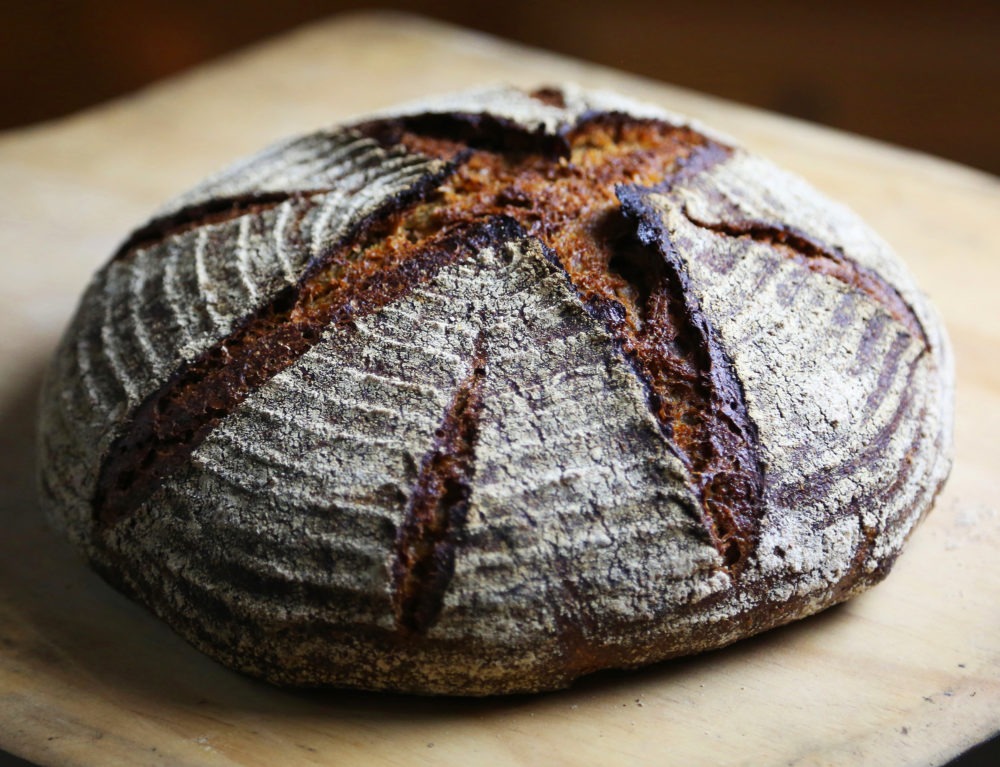eDJ_
Well-known member
Here is a craft you can try in camp when you are kicked back for a few days. You only need a few ingredients
and a stop by a Home Brew Shop to buy a cheap bag of pelletized Hops. You'll also need some potatoes, corn meal,
and perhaps some whole wheat flour. You may have the other stuff already on hand.
I used to watch my Dad make this stuff and I remember the one of a kind biscuits and rolls he made with it.
Dried Hopped yeast cakes:
These are for those who want to make their own hop yeast leavener. The ingredients necessary are two medium potatoes, one to one and one half ounces of pelletized hops and a little white cornmeal.
Wash and peal the potatoes, boil until cooked, then mash them until smooth as you can get them. Place hops (you'll have to experiment with amount but I'd suggest may five pellets) in 2 quarts of water in a cheese cloth sack and simmer them slowly for a half an hour. Then strain off the hop liquid into the mashed potatoes. Place this mixture in plastic bowl (never metal) cover with lid or plastic wrap and allow it to remain at room temps for twenty four hours.
Second step:
Take one half to one cup (amount varies) of corn meal and scald it with enough hot water to make a paste. Take this mixture and combine it with the hop liquid & potato mixture, after it has aged for another twenty four hours. Mix the two thoroughly so that a completely smooth blend is made. If needed, and enough more dry cornmeal so that the mixture can be rolled out on a dough board to a one third inch thickness. Cut the dough sheet into three inch squares, then set them aside in a dry airy place. Turn these several times a day until they are completely dry.
Store these in tightly sealed jars and use as needed.
When you get low on these you can boil some more hops, potatoes, and corn meal and repeat the process and put a cake in some warm water to dissolve it. Then stir this into the new mixture as it will get the next batch fermenting again
and with each batch improve the flavor. You can also give friends a couple of these cakes to start their own batch of sourdough starter.
To get this starter ready to use for making bread, pizza dough, cakes, cinnamon rolls, or whatever......
Place a couple of cakes of starter into a PLASTIC or glass bowl and add some warm water to dissolve. Wait until it starts to bubble and become active, use it with your favorite bread & dough recipes.
I've even used it with my bread machine.
Yes the difference in taste and flavor is much different than that of Fleishmann's or Red Star. King Arthur offers a French Sourdough starter but a 5 gram (8 1/4 tsp makes 8 loafs) envelope is $10+. (called Florapan) but you could use 1/4 tsp to make your own starter and keep it going.
This may be fun to do as a demo at a Rally or Weekend meetup. Then bake some French artisan bread in a Dutch Oven on a camp fire. And again, this would be cheap enough to do.

You can add cocoa powder, molasses, etc to darken your craft bread if you so choose. But just experiment with your favorite bread recipe.
Pelletized hops:

and a stop by a Home Brew Shop to buy a cheap bag of pelletized Hops. You'll also need some potatoes, corn meal,
and perhaps some whole wheat flour. You may have the other stuff already on hand.
I used to watch my Dad make this stuff and I remember the one of a kind biscuits and rolls he made with it.
Dried Hopped yeast cakes:
These are for those who want to make their own hop yeast leavener. The ingredients necessary are two medium potatoes, one to one and one half ounces of pelletized hops and a little white cornmeal.
Wash and peal the potatoes, boil until cooked, then mash them until smooth as you can get them. Place hops (you'll have to experiment with amount but I'd suggest may five pellets) in 2 quarts of water in a cheese cloth sack and simmer them slowly for a half an hour. Then strain off the hop liquid into the mashed potatoes. Place this mixture in plastic bowl (never metal) cover with lid or plastic wrap and allow it to remain at room temps for twenty four hours.
Second step:
Take one half to one cup (amount varies) of corn meal and scald it with enough hot water to make a paste. Take this mixture and combine it with the hop liquid & potato mixture, after it has aged for another twenty four hours. Mix the two thoroughly so that a completely smooth blend is made. If needed, and enough more dry cornmeal so that the mixture can be rolled out on a dough board to a one third inch thickness. Cut the dough sheet into three inch squares, then set them aside in a dry airy place. Turn these several times a day until they are completely dry.
Store these in tightly sealed jars and use as needed.
When you get low on these you can boil some more hops, potatoes, and corn meal and repeat the process and put a cake in some warm water to dissolve it. Then stir this into the new mixture as it will get the next batch fermenting again
and with each batch improve the flavor. You can also give friends a couple of these cakes to start their own batch of sourdough starter.
To get this starter ready to use for making bread, pizza dough, cakes, cinnamon rolls, or whatever......
Place a couple of cakes of starter into a PLASTIC or glass bowl and add some warm water to dissolve. Wait until it starts to bubble and become active, use it with your favorite bread & dough recipes.
I've even used it with my bread machine.
Yes the difference in taste and flavor is much different than that of Fleishmann's or Red Star. King Arthur offers a French Sourdough starter but a 5 gram (8 1/4 tsp makes 8 loafs) envelope is $10+. (called Florapan) but you could use 1/4 tsp to make your own starter and keep it going.
This may be fun to do as a demo at a Rally or Weekend meetup. Then bake some French artisan bread in a Dutch Oven on a camp fire. And again, this would be cheap enough to do.

You can add cocoa powder, molasses, etc to darken your craft bread if you so choose. But just experiment with your favorite bread recipe.
Pelletized hops:



































































